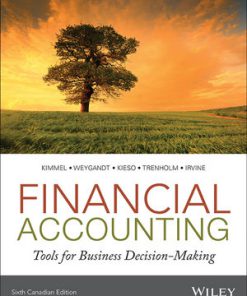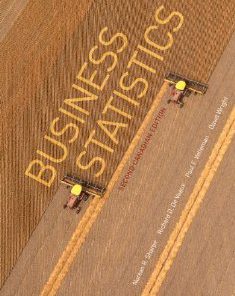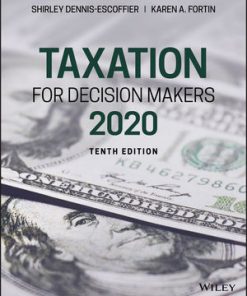Test Bank for Financial Management for Decision Makers, Second Canadian Edition, 2/E 2nd Edition Peter Atrill Paul Hurley
$59.00 Original price was: $59.00.$29.99Current price is: $29.99.
Test Bank for Financial Management for Decision Makers, Second Canadian Edition, 2/E 2nd Edition Peter Atrill Paul Hurley
This is completed downloadable of Test Bank for Financial Management for Decision Makers, Second Canadian Edition, 2/E 2nd Edition Peter Atrill, Paul Hurley

Product Details:
- ISBN-10 : 0138011605
- ISBN-13 : 978-0138011604
- Author: Peter Atrill, Paul Hurley
Teaching students how to use financial management to make decisions, this new edition is written in an accessible style with ample examples and problems providing students with all of the practical skills needed to succeed. Atrill introduces each topic carefully to enable the user to build their knowledge gradually and has the right mix of qualitative and quantitative material that students need in this type of course.
Table of Content:
Cover……Page 1
Title Page……Page 4
Copyright Page……Page 5
Contents……Page 6
Preface……Page 14
Acknowledgements……Page 15
Learning outcomes……Page 20
The finance function……Page 21
Modern financial management……Page 23
Why do businesses exist?……Page 24
Balancing risk and return……Page 33
Behaving ethically……Page 34
Protecting shareholders’ interests……Page 37
Shareholder involvement……Page 41
Summary……Page 48
Further reading……Page 49
Review questions……Page 50
Learning outcomes……Page 52
Planning for the future……Page 53
The role of projected financial statements……Page 54
The sales forecast……Page 55
Preparing the projected statements: a worked example……Page 56
Projected cash flow statement……Page 57
Projected income statement……Page 61
Projected statement of financial position (balance sheet)……Page 62
Projected financial statements and decision making……Page 63
Per-cent-of-sales method……Page 65
Long-term cash flow projections……Page 69
Taking account of risk……Page 72
Financial gearing……Page 75
Operating gearing……Page 83
Combined gearing effect……Page 89
Summary……Page 91
Further reading……Page 93
Exercises……Page 94
Learning outcomes……Page 102
Financial ratio classifications……Page 103
The need for comparison……Page 105
Calculating the ratios……Page 106
Profitability……Page 108
Efficiency……Page 115
Relationship between profitability and efficiency……Page 120
Liquidity……Page 122
Financial gearing……Page 124
Investment ratios……Page 126
Financial ratios and the problem of overtrading……Page 135
Trend analysis……Page 136
Using ratios to predict financial failure……Page 137
Limitations of ratio analysis……Page 142
Summary……Page 147
Key terms……Page 148
Exercises……Page 149
Learning outcomes……Page 158
The nature of investment decisions……Page 159
Investment appraisal methods……Page 161
Accounting rate of return (ARR)……Page 162
Payback period (PP)……Page 167
Net present value (NPV)……Page 170
Why NPV is better……Page 179
Internal rate of return (IRR)……Page 180
Some practical points……Page 185
Investment appraisal in practice……Page 189
The investment appraisal process……Page 193
Investment decisions and human behaviour……Page 199
Summary……Page 200
Further reading……Page 202
Exercises……Page 203
Learning outcomes……Page 210
Investment decisions when funds are limited……Page 211
Comparing projects with unequal lives……Page 215
The ability to delay……Page 218
The problem of inflation……Page 219
The problem of risk……Page 220
Sensitivity analysis……Page 222
Scenario analysis……Page 229
Simulations……Page 230
Risk preferences of investors……Page 232
Risk-adjusted discount rate……Page 235
Expected net present value (ENPV)……Page 237
Event tree diagrams……Page 240
Risk and the standard deviation……Page 243
The expected value–standard deviation rule……Page 247
The limits of probability analysis……Page 248
Portfolio effects and risk reduction……Page 250
Summary……Page 258
Key terms……Page 260
Exercises……Page 261
Learning outcomes……Page 266
External sources of finance……Page 267
External sources of long-term finance……Page 268
Attitudes towards the level of borrowing……Page 282
External sources of short-term finance……Page 291
Long-term versus short-term borrowing……Page 296
Internal sources of finance……Page 297
Internal sources of long-term finance……Page 298
Internal sources of short-term finance……Page 299
Summary……Page 305
Key terms……Page 306
Exercises……Page 307
Learning outcomes……Page 312
The Stock Exchange……Page 313
Stock market efficiency……Page 318
Are the stock markets really efficient?……Page 324
Share issues……Page 328
Long-term finance for the smaller business……Page 336
Business angels……Page 345
Government and EU assistance……Page 348
The Alternative Investment Market (AIM)……Page 349
Summary……Page 353
References……Page 355
Exercises……Page 356
Learning outcomes……Page 362
Cost of capital……Page 363
Weighted average cost of capital (WACC)……Page 378
Specific or average cost of capital?……Page 381
Limitations of the WACC approach……Page 382
Cost of capital – some evidence……Page 383
The capital structure debate……Page 385
Gearing and signalling……Page 395
Summary……Page 396
Review questions……Page 398
Exercises……Page 399
Learning outcomes……Page 406
Paying dividends……Page 407
Dividend distributions in practice……Page 409
Dividend policy and shareholder wealth……Page 410
The importance of dividends……Page 417
Factors determining the level of dividends……Page 422
Dividend policy and management attitudes: some evidence……Page 426
Dividend smoothing in practice……Page 428
What should managers do?……Page 429
Alternatives to cash dividends……Page 430
Summary……Page 439
Further reading……Page 441
Exercises……Page 442
Learning outcomes……Page 446
What is working capital?……Page 447
The scale of working capital……Page 448
Managing inventories……Page 451
Inventories management models……Page 456
Managing trade receivables……Page 462
Managing cash……Page 473
Managing trade payables……Page 481
Summary……Page 485
Review questions……Page 488
Exercises……Page 489
Learning outcomes……Page 494
Creating shareholder value……Page 495
The need for new forms of measurement……Page 496
Net present value (NPV) analysis……Page 498
Managing the business with shareholder value analysis……Page 505
Implications of SVA……Page 506
Economic value added (EVA®)……Page 507
EVA®-based ratios……Page 512
EVA® in practice……Page 513
EVA® and SVA compared……Page 514
EVA® or SVA?……Page 516
Market value added (MVA)……Page 518
The link between MVA and EVA®……Page 520
Limitations of MVA……Page 521
Total shareholder return……Page 523
Criticisms of the shareholder value approach……Page 526
Measuring the value of future growth……Page 527
Shareholder value and directors’ rewards……Page 529
Summary……Page 534
Further reading……Page 536
Exercises……Page 537
Learning outcomes……Page 542
Merger and takeover activity……Page 543
The rationale for mergers……Page 544
Wealth-enhancing motives for mergers……Page 545
Other motives for mergers……Page 550
Forms of purchase consideration……Page 552
Mergers and financial outcomes……Page 555
Who benefits?……Page 558
The merger puzzle……Page 561
Rejecting a takeover bid……Page 562
Restructuring a business: divestments and demergers……Page 566
The valuation of shares……Page 569
Summary……Page 582
References……Page 584
Exercises……Page 585
Appendix A Present value table……Page 594
Appendix B Annual equivalent factor table……Page 596
Appendix C Solutions to self-assessment questions……Page 598
Appendix D Solutions to review questions……Page 610
Appendix E Solutions to selected exercises……Page 620
Glossary……Page 644
Index……Page 654
People Also Search:
financial management for decision makers second canadian edition
financial management for decision makers second canadian edition download scribd
financial management for decision makers second canadian edition test bank download pdf
You may also like…
Test Bank
Test Bank for Principles of Educational Psychology, Second Canadian Edition, 2/E 2nd Edition
Solution Manual
Solution Manual
Test Bank
Test Bank for Comprehensive Nursing Care Revised Second Edition, 2/E 2nd Edition : 0132876825












